– 2 –
WD 2nd Ed. 61980-1:20xx © IEC 20xx
CONTENTS
CONTENTS ............................................................................................................................ 2
FOREWORD ........................................................................................................................... 7
INTRODUCTION ..................................................................................................................... 9
1
Scope ............................................................................................................................ 10
2 Normative references .................................................................................................... 10
3
4
Terms and definitions .................................................................................................... 14
Abbreviations ................................................................................................................ 16
5 General ......................................................................................................................... 17
6 Classification ................................................................................................................. 17
6.1
6.2
6.3
6.4
6.5
General ................................................................................................................. 17
Transfer technologies ........................................................................................... 17
Transfer power classes ......................................................................................... 18
Environmental conditions ...................................................................................... 18
Installation ............................................................................................................ 18
7
Interoperability .............................................................................................................. 18
8 General system requirements ........................................................................................ 19
8.1
8.2
8.3
General ................................................................................................................. 19
Efficiency .............................................................................................................. 20
Measurement convention ...................................................................................... 21
8.3.1
8.3.2
8.3.3
8.3.4
8.3.5
8.3.6
8.3.7
8.3.8
8.3.9
General ......................................................................................................... 21
Orientation ..................................................................................................... 21
Measurement convention of the parking space .............................................. 21
Measurement convention of offset ................................................................. 22
Measurement convention of the primary device ............................................. 23
Distance between the primary and secondary device (mechanical air
gap) ............................................................................................................... 23
Primary device mounting ............................................................................... 24
In-ground-mounting ....................................................................................... 24
On-ground-mounting ...................................................................................... 24
8.4
Primary and secondary device construction .......................................................... 25
9 Communication .............................................................................................................. 25
9.1
9.2
Command and control communication ................................................................... 25
High level communication ..................................................................................... 25
10 Protection against electric shock ................................................................................... 26
10.1 General requirements ........................................................................................... 26
10.2 Protection against direct contact ........................................................................... 26
10.2.1
Degrees of protection against access to hazardous parts .............................. 26
10.2.2
IP degrees for the enclosures ........................................................................ 26
10.2.3
IP degrees for primary device ........................................................................ 26
10.3 Stored energy – discharge of capacitors ............................................................... 26
10.4 Protection against electrical shock ........................................................................ 27
10.5 Protective conductor dimensions ........................................................................... 27
10.6 Supplementary measures ...................................................................................... 27
10.6.1
Additional protection ...................................................................................... 27
10.6.2
Manual/automatic reset ................................................................................. 28
10.7 Telecommunication network .................................................................................. 28
1
2
3
4
5
6
7
8
9
10
11
12
13
14
15
16
17
18
19
20
21
22
23
24
25
26
27
28
29
30
31
32
33
34
35
36
37
38
39
40
41
42
43
44
45
46
47
�
WD 2nd Ed. 61980-1:20xx © IEC 20xx
– 3 –
11 Specific requirements for WPT systems ......................................................................... 28
11.1 General ................................................................................................................. 28
11.2
Leakage – touch current ....................................................................................... 28
11.3
Insulation resistance ............................................................................................. 29
11.4 Dielectric withstand characteristic ......................................................................... 29
11.4.1
Dielectric withstand voltage ........................................................................... 29
11.4.2
Impulse dielectric withstand (1,2/50 µs) ......................................................... 29
11.5 Overload protection and short circuit withstand ..................................................... 30
11.5.1
General ......................................................................................................... 30
11.5.2
Earthing electrode and continuity test ............................................................ 30
11.5.3
Earthing path test .......................................................................................... 30
11.5.4
Short circuit withstand strength ...................................................................... 30
11.6 Temperature rise and protection against thermal incidents .................................... 30
11.6.1
General ......................................................................................................... 30
11.6.2
Permissible surface temperature of accessible parts of the WPT system ....... 31
11.6.3
Temperature limits for materials .................................................................... 32
11.6.4
Protection against burns from heating of foreign objects ................................ 33
11.7 Heat, fire and tracking ........................................................................................... 34
11.8 Protection against mechanical incident ................................................................. 34
11.8.1
Incidents induced by sharp edge.................................................................... 34
11.8.2
Incidents induced by steps from flat ground ................................................... 34
11.9 Areas of protection ................................................................................................ 34
11.10 Protection from electro-magnetic field ................................................................... 35
11.11 Operational safety ................................................................................................. 35
11.12 Emergency service disconnect (optional) .............................................................. 35
12 Power cable assembly requirements .............................................................................. 35
13 Constructional requirements .......................................................................................... 36
13.1 General ................................................................................................................. 36
13.2 Breaking capacity of switching devices ................................................................. 36
13.2.1
General ......................................................................................................... 36
13.2.2
Switch and switch-disconnector ..................................................................... 36
13.2.3
13.2.4
Contactor ....................................................................................................... 36
Circuit-breaker ............................................................................................... 36
13.2.5
Relays ........................................................................................................... 36
13.3 Clearance and creepage distances ....................................................................... 36
13.4 Protection measures ............................................................................................. 37
14 Strength of materials and parts ...................................................................................... 37
14.1 General ................................................................................................................. 37
14.2 Stability/Mechanical impact ................................................................................... 37
14.2.1
Locations with restricted access .................................................................... 37
14.2.2
Locations with non-restricted access ............................................................. 38
14.2.3
14.2.4
Vehicle drive-over .......................................................................................... 38
Lateral force by thrust power ......................................................................... 38
14.3 Mechanical load .................................................................................................... 38
14.3.1
General ......................................................................................................... 38
14.3.2
Static load ..................................................................................................... 38
14.3.3
14.3.4
Shock load .................................................................................................... 39
Torsional stress ............................................................................................. 39
48
49
50
51
52
53
54
55
56
57
58
59
60
61
62
63
64
65
66
67
68
69
70
71
72
73
74
75
76
77
78
79
80
81
82
83
84
85
86
87
88
89
90
91
92
93
94
95
�
– 4 –
WD 2nd Ed. 61980-1:20xx © IEC 20xx
14.3.5
Strength of doors ........................................................................................... 39
14.3.6
Mechanical shock impacts induced by sharp edged objects ........................... 39
14.4 Strength of materials and parts ............................................................................. 39
14.4.1
Protection against corrosion .......................................................................... 39
14.4.2
Test criteria ................................................................................................... 39
14.5 Environmental conditions ...................................................................................... 40
14.6 Properties of insulating materials .......................................................................... 40
14.6.1
14.6.2
Verification of thermal stability of enclosures ................................................. 40
Resistance to fire (Glow wire) ........................................................................ 40
14.6.3
Ball pressure test ........................................................................................... 40
14.6.4
Resistance to tracking ................................................................................... 40
14.6.5
Resistance to ultra-violet radiation ................................................................. 41
14.7 Static strength and stability ................................................................................... 41
14.8 Vibration ............................................................................................................... 41
15 Service and test conditions ............................................................................................ 41
15.1 General ................................................................................................................. 41
15.2 Environmental test ................................................................................................ 41
15.2.1
Ambient air temperature ................................................................................ 41
15.2.2
Ambient humidity ........................................................................................... 42
15.2.3
Ambient air pressure ..................................................................................... 42
15.2.4
Altitude .......................................................................................................... 42
15.2.5
Pollution degree ............................................................................................ 43
15.2.6
15.2.7
Dry heat ........................................................................................................ 43
Cold test ........................................................................................................ 43
15.3 Special service conditions ..................................................................................... 43
15.4 Conditions during transport, storage and installation ............................................. 43
15.5 Outdoor exposure ................................................................................................. 44
15.5.1
Cold test for extreme cold climates ................................................................ 44
15.5.2
Heat test under solar radiation ....................................................................... 44
15.6 Damp and salt mist test for marine and coastal environments ............................... 44
15.7 Condensation within the assembly ........................................................................ 44
15.8 Vibration and shock .............................................................................................. 44
15.9 Safety specifications ............................................................................................. 44
16 Electromagnetic Compatibility (EMC) ............................................................................. 44
16.1
Immunity requirements .......................................................................................... 44
16.2 Disturbance requirement ....................................................................................... 46
16.2.1
Load and operating conditions ....................................................................... 46
16.2.2
Disturbance limits .......................................................................................... 47
17 Marking and instructions ................................................................................................ 50
17.1 General ................................................................................................................. 50
17.2 Marking of EV supply equipment ........................................................................... 51
17.3
Legibility ............................................................................................................... 51
17.4 Connection instructions ......................................................................................... 51
Annex A (informative) Use cases ......................................................................................... 52
A.1
A.2
General ................................................................................................................. 52
Use case descriptions ........................................................................................... 53
A.2.1
A.2.2
UC Select "charging spot" .............................................................................. 53
UC Compatibility Check ................................................................................. 54
96
97
98
99
100
101
102
103
104
105
106
107
108
109
110
111
112
113
114
115
116
117
118
119
120
121
122
123
124
125
126
127
128
129
130
131
132
133
134
135
136
137
138
139
140
141
142
143
�
WD 2nd Ed. 61980-1:20xx © IEC 20xx
– 5 –
A.2.3
A.2.4
A.2.5
A.2.6
A.2.7
A.2.8
UC Fine Positioning ....................................................................................... 55
UC Pairing Confirmation ................................................................................ 56
UC Start Power Transfer ................................................................................ 57
UC Perform Power Transfer ........................................................................... 59
UC Safety Monitoring and Diagnostics (see Table A.7) ................................. 61
UC Stop Power transfer ................................................................................. 61
Annex B (informative) EMC tables, EV connected to an WPT system ................................... 63
B.1
General ................................................................................................................. 63
B.2 WPT equipment immunity requirement (informative) ............................................. 63
B.3
Radio frequency (RF) disturbances ....................................................................... 63
B.4 WPT system with EV included (radiated disturbances in the range 30 MHz to
1 000 MHz) ........................................................................................................... 64
Annex C (informative) EMF, protection from electromagnetic field ....................................... 66
C.1
C.2
C.3
Protection from electromagnetic field .................................................................... 66
Assessment of electronic and electrical equipment ............................................... 66
EMF measurement procedure ............................................................................... 66
C.4 Measurement points .............................................................................................. 68
C.4.1
C.4.2
C.4.3
Area 3 measurement points of nominal position ............................................. 68
Area 3 measurement points of offset positions ............................................... 69
Area 4 measurement points ........................................................................... 69
Bibliography .......................................................................................................................... 70
Figure 1 – Installation ........................................................................................................... 18
Figure 2 – Wireless Power Transfer system .......................................................................... 20
Figure 3 – Position of axes relative to orientation .................................................................. 21
Figure 4 – Position of the primary device .............................................................................. 22
Figure 5 – X and Y maximum offset ...................................................................................... 23
Figure 6 – In-ground-mounting .............................................................................................. 24
Figure 7 – On-ground-mounting ............................................................................................ 25
Figure 8 – Qualitative example of material temperature ........................................................ 31
Figure 9 – Example for areas of protection, for ground mounted systems .............................. 35
Figure A.1 – Use cases particularly for wireless power transfer ............................................. 52
Figure A.2 – Use cases from ISO/IEC 15118-1 reusable for WPT systems ............................ 53
Figure A.3 – Activity diagram for UC Select "Charging Spot" ................................................. 54
Figure A.4 – Activity diagram for UC Compatibility Check ..................................................... 55
Figure A.5 – Activity diagram for UC Fine Positioning ........................................................... 56
Figure A.6 – Activity diagram fur UC Pairing Confirmation .................................................... 57
Figure A.7 – Activity diagram for UC Start Power Transfer .................................................... 59
Figure A.8 – Activity diagram for UC Perform Power Transfer ............................................... 60
Figure A.9 – Activity diagram for UC Stop Power Transfer .................................................... 62
Figure B.1 – EV model for the radiated emission measurement (top view) ............................ 64
Figure B.2 – EV model for radiated emission measurements (side view) ............................... 65
Figure C.1 – Top view ........................................................................................................... 68
Figure C.2 – Front view ......................................................................................................... 68
Figure C.3 – Seats position ................................................................................................... 69
144
145
146
147
148
149
150
151
152
153
154
155
156
157
158
159
160
161
162
163
164
165
166
167
168
169
170
171
172
173
174
175
176
177
178
179
180
181
182
183
184
185
186
187
188
�
– 6 –
WD 2nd Ed. 61980-1:20xx © IEC 20xx
189
190
191
192
193
194
195
196
197
198
199
200
201
202
203
204
205
206
207
208
209
210
211
212
213
Figure C.4 – Measurement points of seats ............................................................................ 69
Table 1 – Transfer technologies ............................................................................................ 17
Table 2 – Position of primary device ..................................................................................... 22
Table 3 – Offset .................................................................................................................... 23
Table 4 – Primary device ...................................................................................................... 23
Table 5 – Mechanical air gap ................................................................................................ 24
Table 6 – Touch currents ...................................................................................................... 28
Table 7 – Values of temperature rise in normal use .............................................................. 33
Table 8 – WPT equipment immunity requirement – Environment other than residential ........ 45
Table 9 – WPT equipment immunity requirement – residential environment .......................... 46
Table 10 – Low frequency disturbances ................................................................................ 48
Table 11 – Radio frequency (RF) disturbances ..................................................................... 49
Table 12 – Limits of the magnetic field strength for WPT system ........................................... 50
Table A.1 – UC Select "charging spot" .................................................................................. 53
Table A.2 – UC Compatibility Check ..................................................................................... 55
Table A.3 – UC Fine Positioning ........................................................................................... 56
Table A.4 – UC Pairing Confirmation .................................................................................... 57
Table A.5 – UC Start Power Transfer .................................................................................... 58
Table A.6 – UC Perform Power Transfer ............................................................................... 60
Table A.7 – UC Safety Monitoring and Diagnostics .............................................................. 61
Table A.8 – UC Stop Power transfer ..................................................................................... 61
Table B.1 – Environment other than residential environment with EV .................................... 63
Table B.2 – Residential environment with EV ........................................................................ 63
Table B.3 – Radio frequency (RF) disturbances – WPT system with EV ................................ 63
214
215
�
WD 2nd Ed. 61980-1:20xx © IEC 20xx
– 7 –
216
217
218
219
220
221
222
223
224
225
226
227
228
229
230
231
232
233
234
235
236
237
238
239
240
241
242
243
244
245
246
247
248
249
250
251
252
253
254
255
256
257
258
259
INTERNATIONAL ELECTROTECHNICAL COMMISSION
____________
ELECTRIC VEHICLE WIRELESS
POWER TRANSFER (WPT) SYSTEMS –
Part 1: General requirements
FOREWORD
1) The International Electrotechnical Commission (IEC) is a worldwide organization for standardization comprising
all national electrotechnical committees (IEC National Committees). The object of IEC is to promote
international co-operation on all questions concerning standardization in the electrical and electronic fields. To
this end and in addition to other activities, IEC publishes International Standards, Technical Specifications,
Technical Reports, Publicly Available Specifications (PAS) and Guides (hereafter referred to as “IEC
Publication(s)”). Their preparation is entrusted to technical committees; any IEC National Committee interested
in the subject dealt with may participate in this preparatory work. International, governmental and non-
governmental organizations liaising with the IEC also participate in this preparation. IEC collaborates closely
with the International Organization for Standardization (ISO) in accordance with conditions determined by
agreement between the two organizations.
2) The formal decisions or agreements of IEC on technical matters express, as nearly as possible, an international
consensus of opinion on the relevant subjects since each technical committee has representation from all
interested IEC National Committees.
3) IEC Publications have the form of recommendations for international use and are accepted by IEC National
Committees in that sense. While all reasonable efforts are made to ensure that the technical content of IEC
Publications is accurate, IEC cannot be held responsible for the way in which they are used or for any
misinterpretation by any end user.
4) In order to promote international uniformity, IEC National Committees undertake to apply IEC Publications
transparently to the maximum extent possible in their national and regional publications. Any divergence
between any IEC Publication and the corresponding national or regional publication shall be clearly indicated in
the latter.
5) IEC itself does not provide any attestation of conformity. Independent certification bodies provide conformity
assessment services and, in some areas, access to IEC marks of conformity. IEC is not responsible for any
services carried out by independent certification bodies.
6) All users should ensure that they have the latest edition of this publication.
7) No liability shall attach to IEC or its directors, employees, servants or agents including individual experts and
members of its technical committees and IEC National Committees for any personal injury, property damage or
other damage of any nature whatsoever, whether direct or indirect, or for costs (including legal fees) and
expenses arising out of the publication, use of, or reliance upon, this IEC Publication or any other IEC
Publications.
8) Attention is drawn to the Normative references cited in this publication. Use of the referenced publications is
indispensable for the correct application of this publication.
9) Attention is drawn to the possibility that some of the elements of this IEC Publication may be the subject of
patent rights. IEC shall not be held responsible for identifying any or all such patent rights.
International Standard IEC 61980-1 has been prepared by Technical Committee 69: Electric
road vehicles and electric industrial trucks.
260
The text of this standard is based on the following documents:
FDIS
Report on voting
69/370/FDIS
69/380/RVD
261
262
263
Full information on the voting for the approval of this standard can be found in the report on
voting indicated in the above table.
264
This publication has been drafted in accordance with the ISO/IEC Directives, Part 2.
265
�
– 8 –
WD 2nd Ed. 61980-1:20xx © IEC 20xx
266
This part is to be used in conjunction with the appropriate part of IEC 61980 series.
267
268
269
270
271
272
273
274
275
276
277
NOTE The following print types are used:
–
–
–
requirements: in roman type;
test specifications: in italic type;
notes: in small roman type.
The committee has decided that the contents of this publication will remain unchanged until
the stability date indicated on the IEC website under "http://webstore.iec.ch" in the data
related to the specific publication. At this date, the publication will be
•
reconfirmed,
• withdrawn,
•
replaced by a revised edition, or
• amended.
278
A bilingual version of this publication may be issued at a later date.
IMPORTANT – The 'colour inside' logo on the cover page of this publication indicates
that
it contains colours which are considered to be useful for the correct
understanding of its contents. Users should therefore print this document using a
colour printer.
279
280
281
�
WD 2nd Ed. 61980-1:20xx © IEC 20xx
– 9 –
282
INTRODUCTION
283
The IEC 61980 series is published in separate parts according to the following structure:
284
285
286
287
288
289
290
291
292
293
294
295
296
297
298
299
300
301
302
Part 1 covers general requirements for electric road vehicle (EV) wireless power transfer
(WPT) systems including general background and definitions (e.g. efficiency, electrical safety,
EMC, EMF).
Future Part 2 will cover specific requirements for communication between electric road vehicle
(EV) and wireless power
including general background and
definitions.
transfer (WPT) systems
Future Part 3 will cover specific requirements for electric road vehicle (EV) magnetic field
wireless power transfer (MF-WPT) systems including general background and definitions (e.g.
efficiency, electrical safety, EMC, EMF).
The requirements described in Part 1 are general. The technical requirements for the various
wireless power transfer (WPT) technologies are very different, they will be treated in
technology specific parts of the 61980 series. A list of possible WPT technologies can be
seen in 6.2. The requirements for magnetic field-wireless power transfer systems (MF-WPT)
will be described in future Part 3. Further parts of this series will describe other technologies
such as power transfer via electric field wireless power transfer systems (EF-WPT) or
electromagnetic field-WPT systems also named microwave-WPT systems (MW-WPT).
Reference to "technology specific parts" always refer to the technology specific future Part 3
and further technology specific parts of this series. The structure of the "technology specific
parts" will follow the structure of Part 1.
303
Electric road vehicle (EV) will be covered by ISO 193631.
304
___________
1 Under consideration.
�
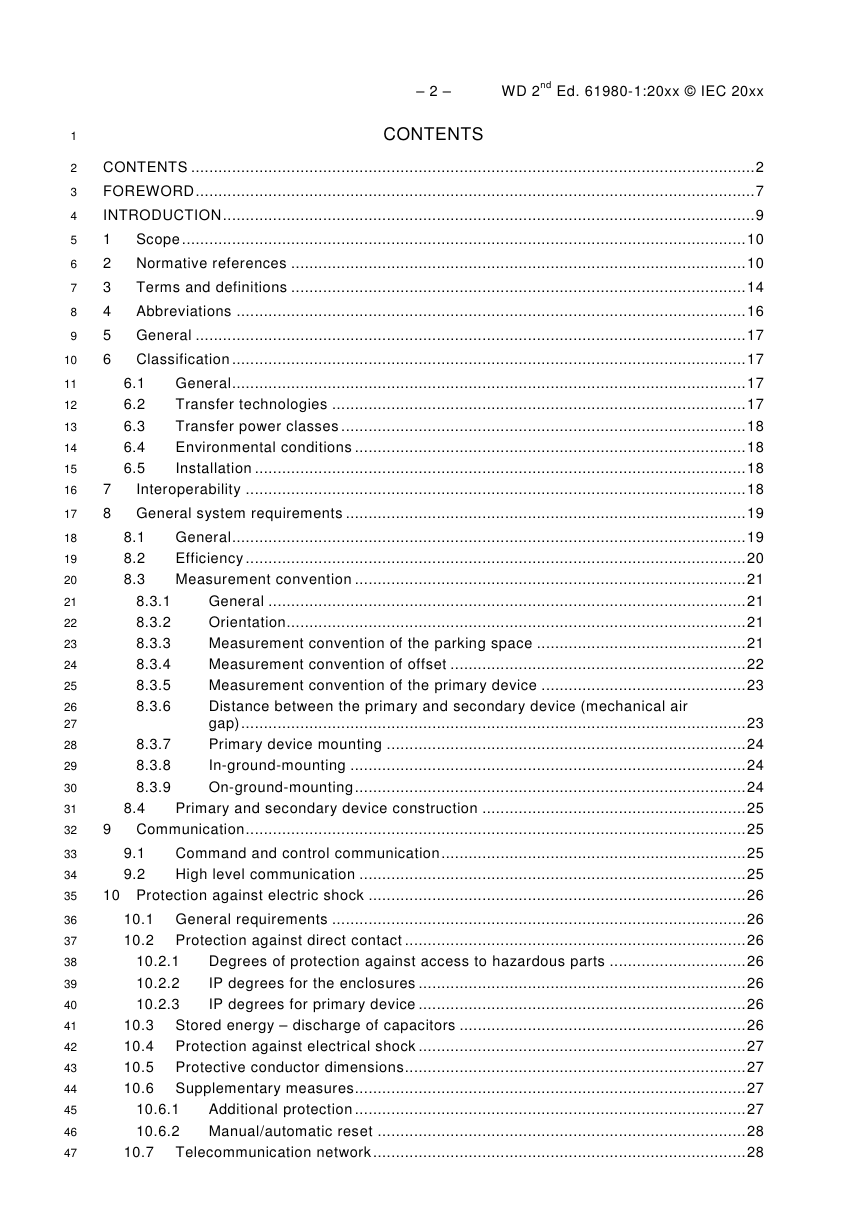
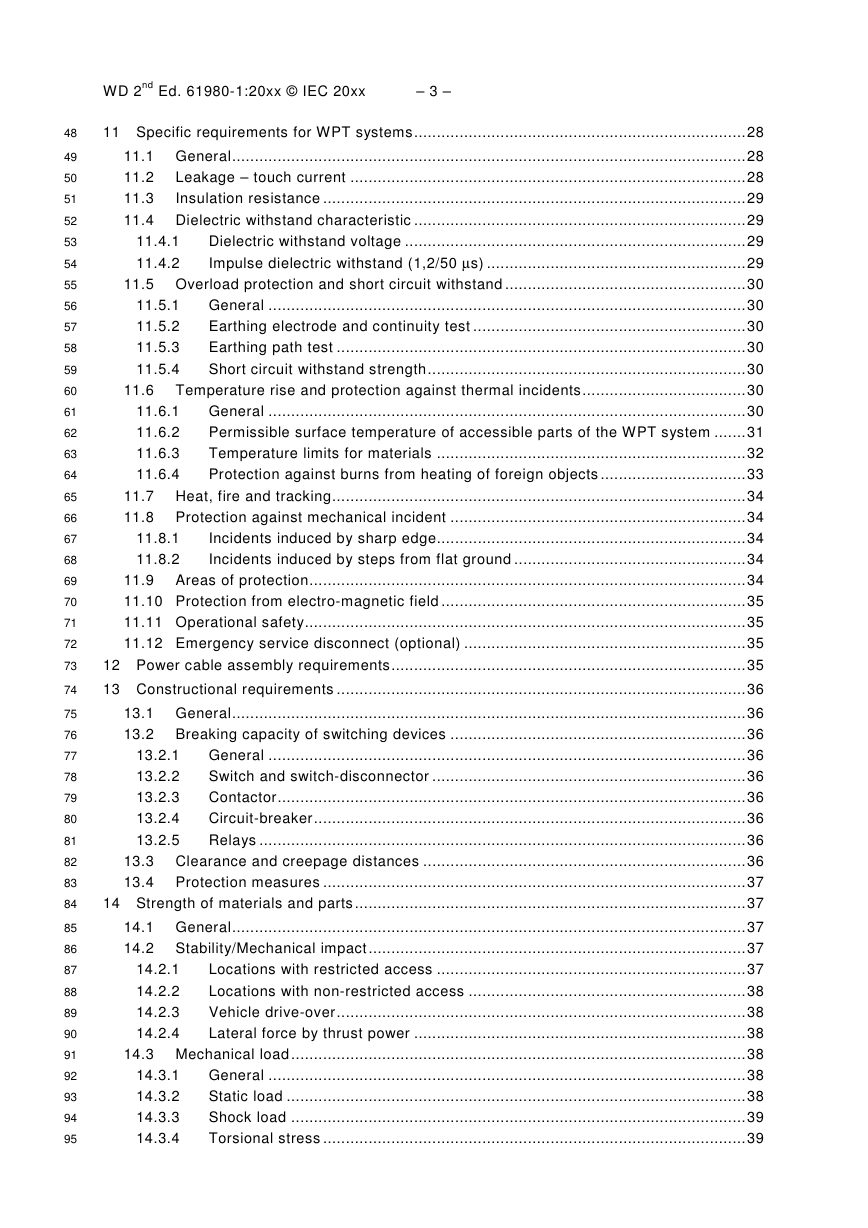
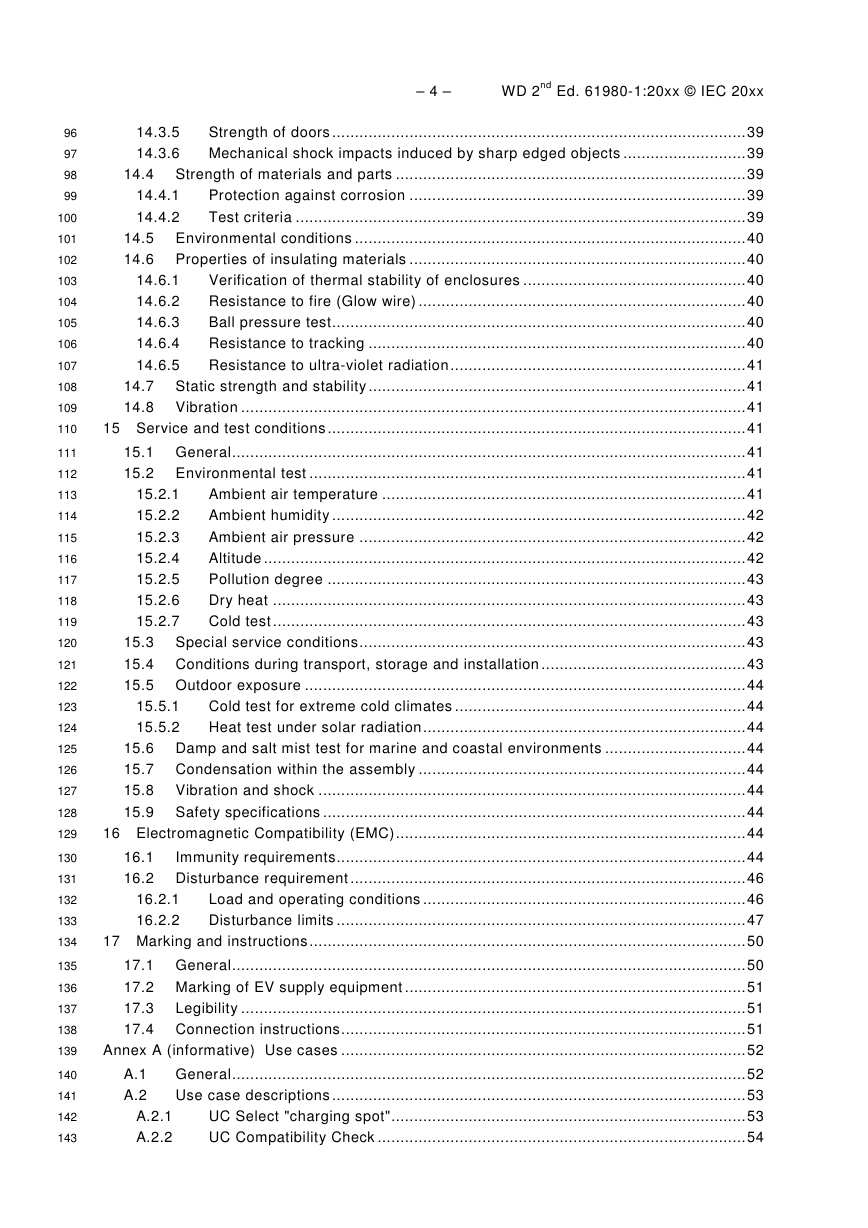
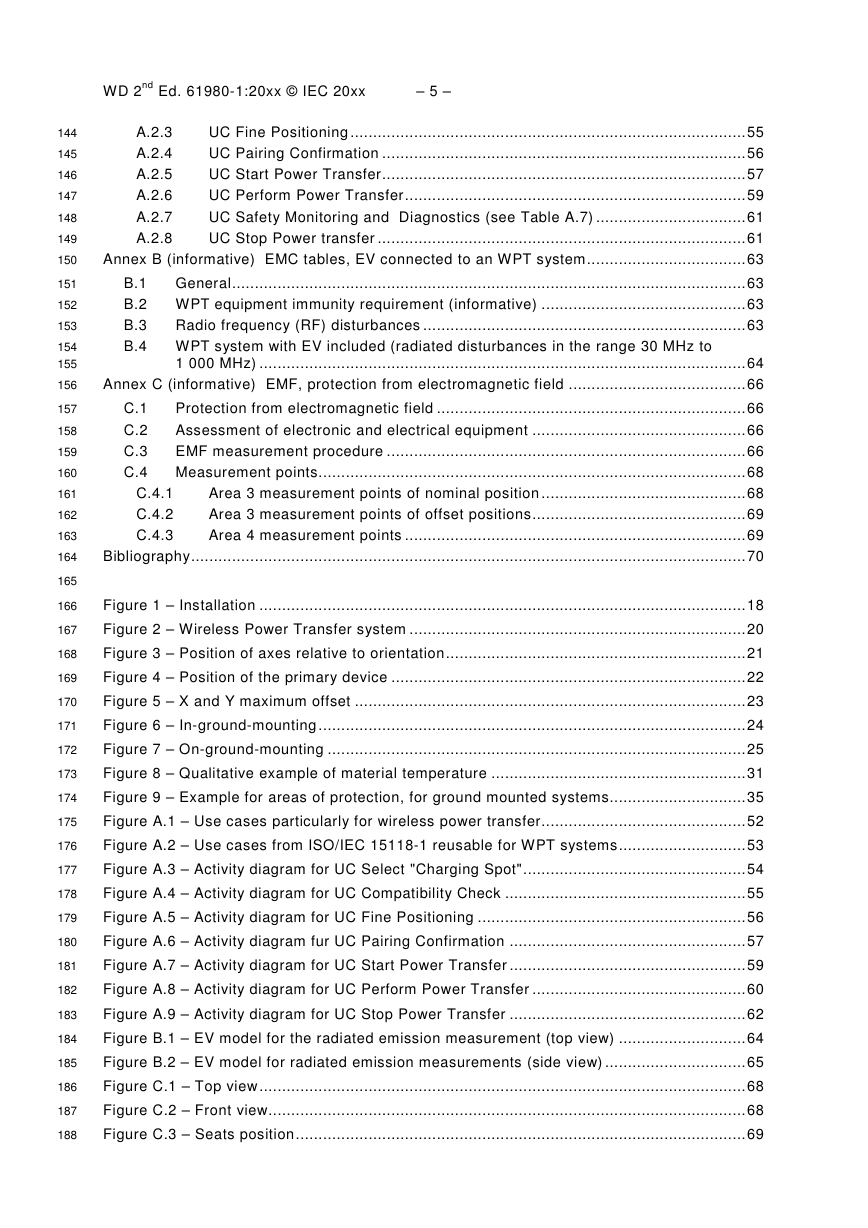
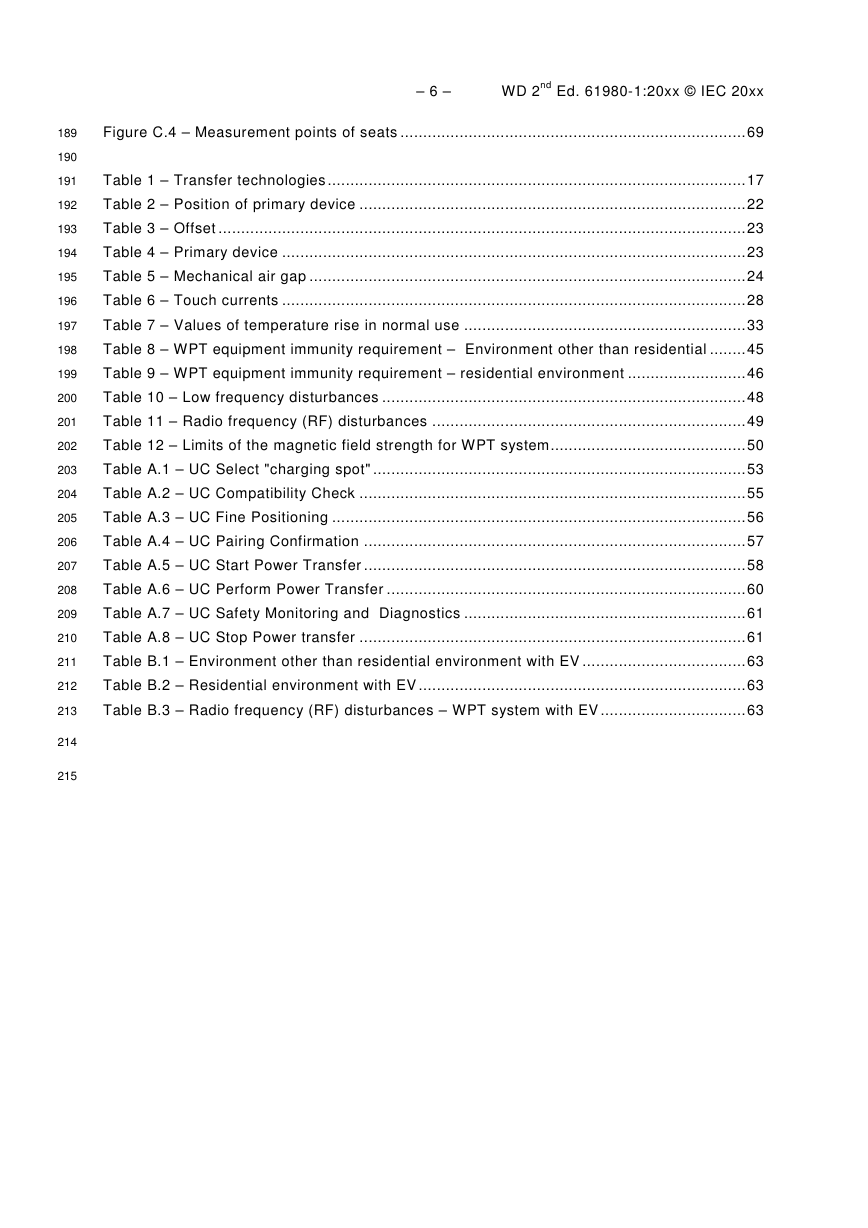
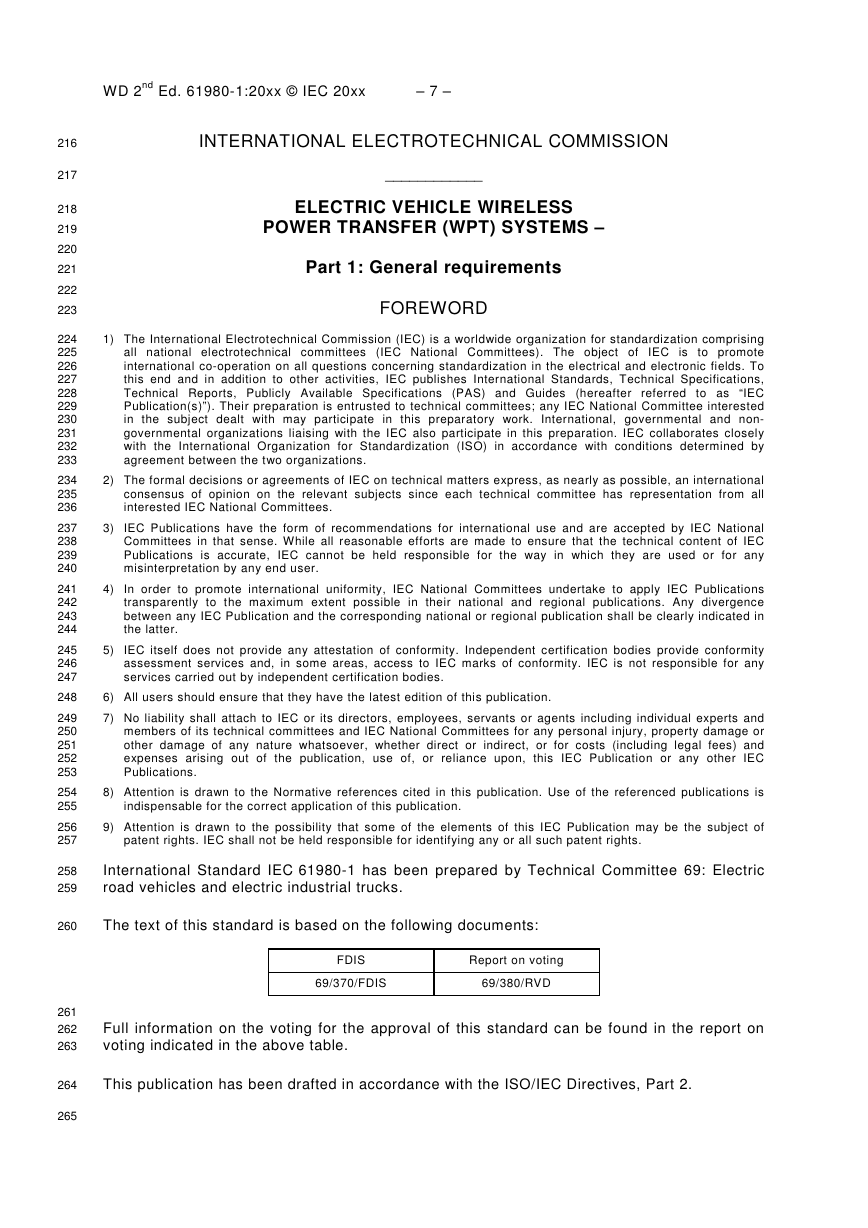
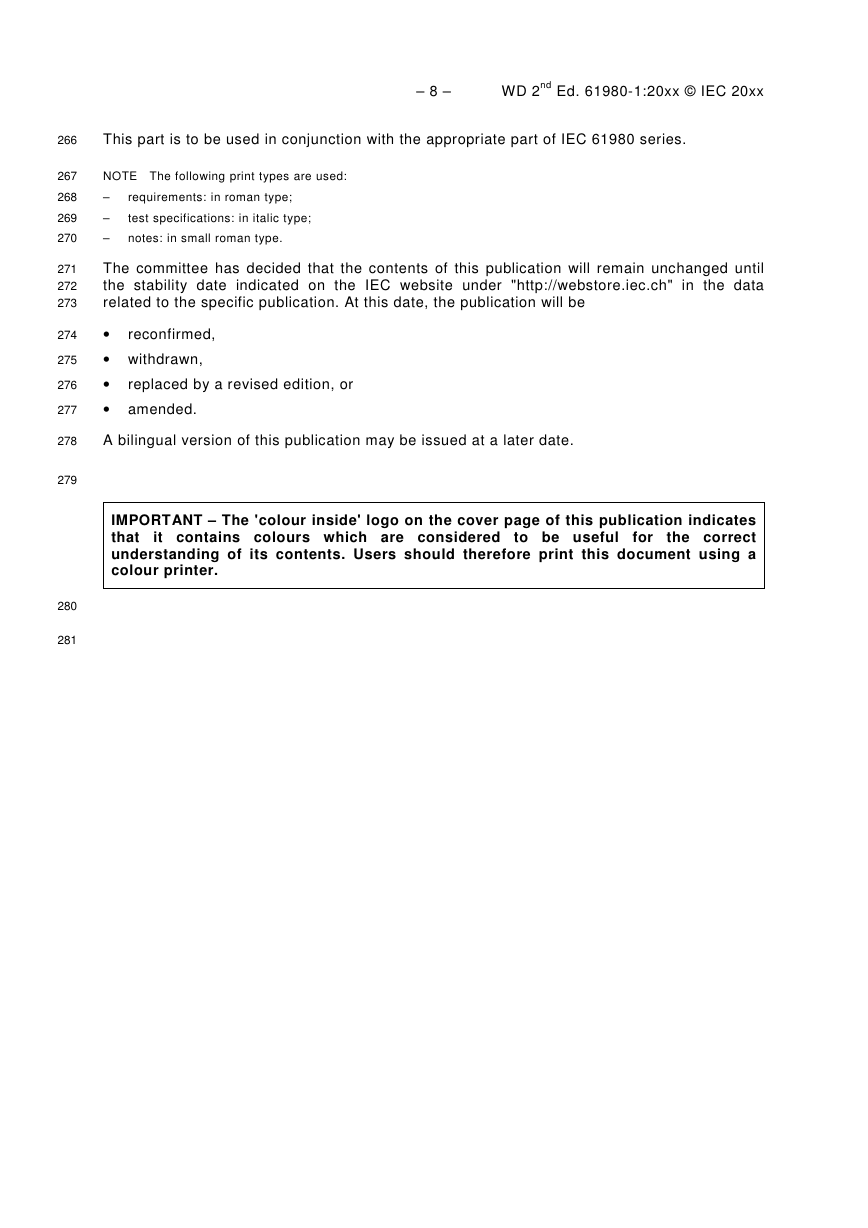
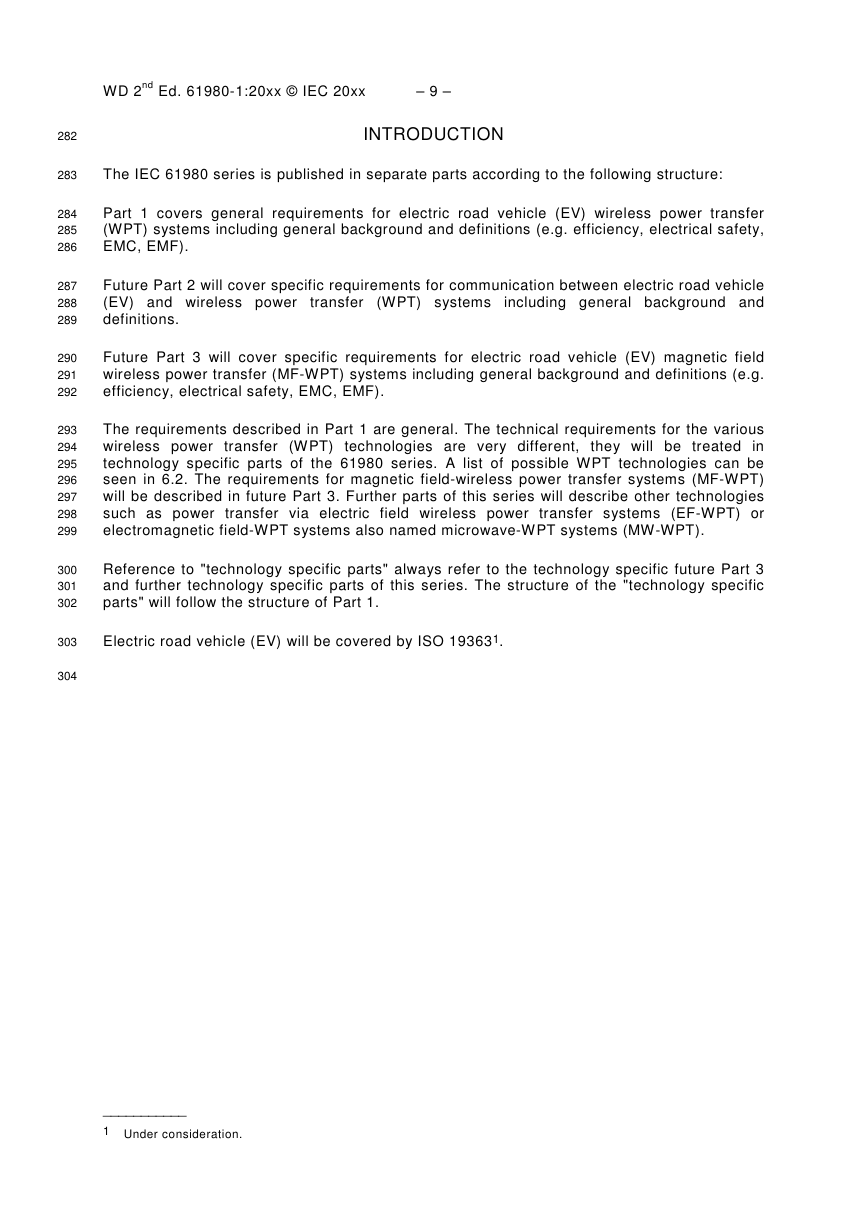








 2023年江西萍乡中考道德与法治真题及答案.doc
2023年江西萍乡中考道德与法治真题及答案.doc 2012年重庆南川中考生物真题及答案.doc
2012年重庆南川中考生物真题及答案.doc 2013年江西师范大学地理学综合及文艺理论基础考研真题.doc
2013年江西师范大学地理学综合及文艺理论基础考研真题.doc 2020年四川甘孜小升初语文真题及答案I卷.doc
2020年四川甘孜小升初语文真题及答案I卷.doc 2020年注册岩土工程师专业基础考试真题及答案.doc
2020年注册岩土工程师专业基础考试真题及答案.doc 2023-2024学年福建省厦门市九年级上学期数学月考试题及答案.doc
2023-2024学年福建省厦门市九年级上学期数学月考试题及答案.doc 2021-2022学年辽宁省沈阳市大东区九年级上学期语文期末试题及答案.doc
2021-2022学年辽宁省沈阳市大东区九年级上学期语文期末试题及答案.doc 2022-2023学年北京东城区初三第一学期物理期末试卷及答案.doc
2022-2023学年北京东城区初三第一学期物理期末试卷及答案.doc 2018上半年江西教师资格初中地理学科知识与教学能力真题及答案.doc
2018上半年江西教师资格初中地理学科知识与教学能力真题及答案.doc 2012年河北国家公务员申论考试真题及答案-省级.doc
2012年河北国家公务员申论考试真题及答案-省级.doc 2020-2021学年江苏省扬州市江都区邵樊片九年级上学期数学第一次质量检测试题及答案.doc
2020-2021学年江苏省扬州市江都区邵樊片九年级上学期数学第一次质量检测试题及答案.doc 2022下半年黑龙江教师资格证中学综合素质真题及答案.doc
2022下半年黑龙江教师资格证中学综合素质真题及答案.doc